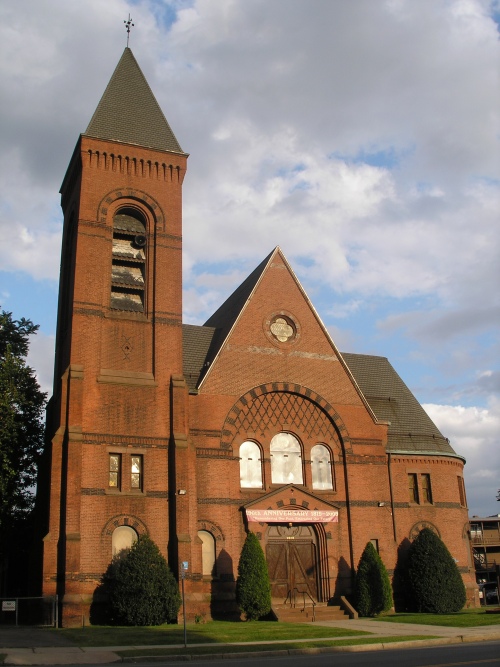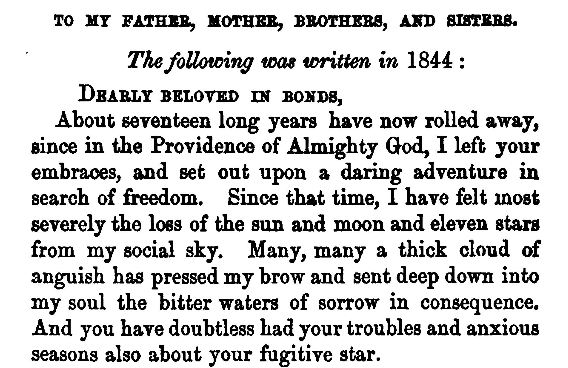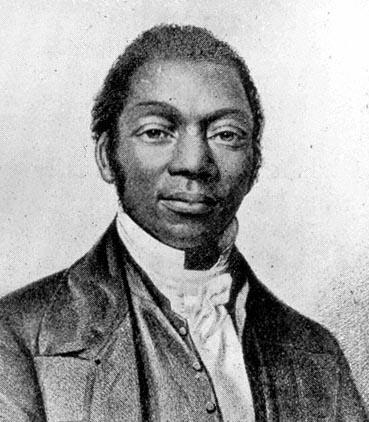By Stacey Close for Connecticut Explored
In 1827 James Pembroke, an enslaved man of African descent who would eventually take the name James William Charles (WC) Pennington, managed to escape from bondage in Maryland to freedom in the North. According to his narrative, he experienced an early childhood of parental separation. His father, Brazil Pembroke (whose last name was that of his owner) resided on the land of one slaveholder, while his mother lived with another slave owner. His life changed after his mother’s owner agreed to purchase his father. Consequently, both parents were able to live with their family.
Even with parents present, James quickly discovered that the condition of slavery carried few exemptions from torture, even for children, on the small farm. While his owner’s children were cruel, the actions of the overseer, Blackstone, chilled his soul. James made the horrible mistake of playfully picking up one of the hickory switches that Blackstone kept to whip the enslaved who broke his rules. When the overseer saw James riding the long switch like a horse, the man flew into a rage and savagely beat the child with another piece of hickory that he kept handy. The level of fear in the child reached a point where he decided to seek refuge for hours in the woods or some other hiding place for fear of a beating by Blackstone.
The feudal system of chattel slavery had little use for idle hands; consequently, his owner tendered the nine-year-old to a stonemason. His brother, also a mere child, received training with a pump-maker. The owner no longer had to house or feed the children, while in return he would soon receive the services of a skilled craftsman. The pump-maker offered to purchase his brother, and James’s owner agreed to the sale. The two brothers remained separated thereafter. They were no closer in distance than six miles. After two years learning the work of a stonemason, James, at his owner’s bidding, went to work where he grew up as a mason in the blacksmith shop. The blacksmith, an enslaved man, had also learned his trade as a young apprentice. When James finished his assigned duties as a mason, he transitioned to learning the trade of the blacksmith. He worked at that trade for nine years.
The desire to be free of the brutality of slavery eventually led James to take flight from Maryland. The violent beating of his father, a shepherd who cared for the owners’ and his own Merino sheep, at the hands of the slave master for appearing to eyeball the white master forced him to make the dash for freedom. Coupled with vicious racial tirades from the owner, he never forgot the dozen blows with the cane that his owner delivered to his body, which left him aching for long periods. With a small morsel of bread and a bundle of clothes, James struck out for freedom, heading for Pennsylvania or some Northern state.
James Takes Flight and Finds Refuge
Although whites captured and detained James during his flight, they allowed him to continue on his way after he lied about being part of a smallpox-infected slave gang about to be sold to Georgia. Although this was clearly untrue, he knew the impact the statement would have and fear it would generate. In 1827, Pennington managed to meet a sympathetic “Christian woman,” who informed him that he was in Pennsylvania, a free state. She sent him to the home of a Quaker, William Wright. Quakers were known for their active role in the anti-slavery movement, and the local members of the Society of Friends sheltered and educated their runaway friend.
With Freedom Comes Change
Through their connections and aid, Pennington eventually made it to New York. While his friends on the Underground Railroad aided in his freedom, their devotion to Jesus played a role in his conversion to Christianity. This conversion set him on the road to abolitionism, teaching, and the ministry. His newly seized freedom gave him the opportunity to choose a new last name, Pennington. Over the years, he would consider among his friends William Lloyd Garrison, Simeon Jocelyn, and Lewis Tappan, leading abolitionists of the day. A decade after acquiring his freedom, Pennington became an ordained minister and studied at Yale University. One of the highlights of his duties as a minister was conducting marriages, particularly of fugitives. In 1838 David Ruggles, an abolitionist and friend, informed him that a fugitive named Frederick Douglass and a woman named Anna Murray wanted to be married. Although Douglass and Murray had no money to pay for the nuptials, Pennington still graciously agreed to marry the couple.
James Pennington Comes to Hartford

Faith Congregational Church, Hartford – Historic Buildings of Connecticut
When Pennington finally made the move to Hartford, he became part of a highly organized and engaged African American community. African Americans, after segregated treatment, formally organized a church in 1826, which eventually became the Talcott Street Congregational Church and later Faith Congregational Church. The church’s quest for Pennington’s services as pastor began in 1838, but he declined the offer. In 1840, though, the determined Hartford congregation managed to persuade the talented minister to relocate. Once installed in the pulpit in Hartford, he pastored the church and taught in a local school for African American children. Although Hartford’s regular school system technically accepted all children, in 1830 African American parents, who disliked the treatment of their children in the regular system, requested a separate school. Parents established the North African and South African schools. They housed the first school at Talcott Street, while African American Methodists provided space for the other school. Amos Beman served as the best known of the early teachers; however, he moved on to pastor the Temple Street Church in New Haven. Politically and socially, James Mars, Henry Foster, and Ann Plato, faithful members of the church, were already formidable leaders in the community. Deacon Mars was a member of the executive committee of the Connecticut Anti-Slavery Society, while Foster led the efforts to develop a state temperance society for African Americans. Mars joined a coalition that fought to free Nancy, an enslaved woman brought from Georgia by her owner. In 1843 Reverend Pennington served as one of the Connecticut Anti-Slavery Society’s delegates to the world anti-slavery convention. At the September 2, 1840 meeting of that organization, he accepted the group’s presidency. In 1844 the talented Plato taught students in the Elm Street School.
Although his eight years as pastor included a trip to England and two years on leave, Pennington plunged headlong into building up the educational and cultural life of African Americans. He knew that he was part of burgeoning leadership class. His writings for the well-respected Colored American, a leading African American newspaper published in New York, revealed his concern and passion for improving the quality of the education and facilities. Members of the state temperance society considered the newspaper “vital” to the empowerment of African Americans. In its pages, Pennington chastised parents and school committees for their failures. He urged parents to be not satisfied with the mere rudiments of education, while he suggested that school committees needed to upgrade buildings, equipment, furniture, and instructional materials.
When Augustus Washington, a Dartmouth College-trained student and future daguerreotypist, came to Hartford, Pennington and his wife taught and served as administrators at a school in two rooms in his church’s lower level. Washington also became a teacher of African American children in Hartford. Although he only taught two years, he impressed Thomas Robbins, a visiting clergyman, with his skills as an educator. When Ann Plato published a collection of her writings, Pennington proudly wrote the foreword. He used her writings as proof that African Americans were capable of intellectual pursuits, not simply the drudgery of slave labor. The minister suggested that African Americans should purchase the book.
Pennington’s Book Challenges Notions of Inferiority
The publication of Pennington’s Textbook of the Origin and History, Etc. Etc. of the Colored People in 1841 served as a further challenge to notions of African American inferiority. He challenged assumptions about the curse of Ham on Africans and also responded to Thomas Jefferson’s arguments about African inferiority. According to historian Donald Spivey, Pennington spent a great deal of his time condemning racism in Hartford. Pennington found whites in the city to be apathetic or hostile toward African American residents. For a short time, the minister published two anti-slavery newspapers (The Northern Star and Clarksonian). The decline of the Colored American and need for African Americans to have a voice of their own in the struggle against slavery and racism prompted his move into publishing. While Pennington understood the importance of the Liberator, published by William Lloyd Garrison, he knew that freedom came with the ability to do for self. Both papers played important roles in the struggle, though both suffered from financial difficulties.

Detail from an article in the Charter Oak, October 28, 1847, describing an address delivered by Rev. Mr. Pennington to The Litchfield Co. Anti-Slavery Society – Connecticut State Library, Newspapers of Connecticut
Pennington’s struggle was not one simply against the masters of slavery. He joined with other leaders to demand that people live upstanding lives. On September 2, 1840, Pennington was among a group of delegates of the Connecticut State Temperance Society who resolved to work to foster a culture of high morals and character. Temperance organizing had been a part of his work since his days in New York.
Becoming Allies to Aid the Amistad Captives
African American and white allies in the city also organized efforts to aid in the support of the Amistad captives. Pennington was at the forefront in forging the Union Missionary Society, which became the American Missionary Society. The society played an instrumental role in funding the Amistad freedom fighters’ travel back to Sierra Leone. A May 1841 public meeting of African Americans addressed concerns about the safe return of the Mendi people to Sierra Leone and the need to send missionaries to Africa. Pennington saw efforts to return the Mendi safely to Africa as divinely inspired. On November 21, 1841, the minister led prayers at services at the Broadway Tabernacle in New York for the departing group. Included were two members of his church, Henry and Tamar Wilson. Henry, who formerly worked as tailor, and his wife would serve as teachers. The couple decided that they wanted to be part of the missionary group to proselytize among the people of Sierra Leone.
While living in Hartford, Pennington boldly continued to champion the cause of runaways and the end to slavery. He continued his earlier work with the New York Vigilance Committee. Throughout the North, vigilance committees used their networks to ensure that runaways had an opportunity to seek freedom. When a family of seven fugitives arrived at Pennington’s door, he welcomed and sheltered them in his home. A dwelling nearby served as their new home. Other people, with his help, filtered into Canada by way of Massachusetts. Pennington, still a runaway at this time, would not know legal freedom until John Hooker, a friend and lawyer, negotiated his purchase from his Maryland slave owner.
In 1847 Pennington and Amos Beman represented Connecticut at the National Convention of Colored People. Pennington presented a commerce resolution that argued for people of African descent to collaborate internationally to improve their economic lives.
Pennington Seeks the Vote for Free Blacks
When Pennington decided to take a two-year absence for “classical studies” and higher education training, his travels outside the country to the Caribbean and British Isles provided him an opportunity to appeal to supporters for financial assistance in his freedom cause. Even as he remained deeply concerned about re-enslavement and the sale of family members throughout his time in Hartford, he stayed vigilant about the lack of voting rights for African Americans in Connecticut. Although the Whigs and the Liberty Party seemed more amenable to aiding the cause of African American voting rights, both parties failed to lead on the issue of enfranchising African Americans. African American leaders argued that they should not pay taxes unless they received representation.
On June 25, 1847, the schoolroom at Talcott Street Church served as the meeting place for a discussion on suffrage. Pennington was part of an appointed three-member corresponding committee. The members at the meeting joyously supported efforts in the legislature to amend the state Constitution to allow African American men to vote. They also urged that representatives in the legislature offer detailed discussions about the issue without prejudice. The state legislature refused to pass a suffrage bill.
Although the struggle for the right to vote failed in the 1840s, Pennington considered it his duty to confront and criticize ministers about racism within the abolitionist movement and clergy leadership. He reported that it was not unusual for white abolitionists to sit down beside him at meeting, only to move to another seat once they recognized the color of his skin. As for white ministers in Connecticut, he chastised them at a Middletown meeting for their failure to accept African American pastors fully in the brotherhood of ministers. In 1843, his criticism appears to have led to his acceptance in the Hartford Central Association, an organization of congregational institutions run by ministers. By 1844, Pennington presented a sermon outline in West Avon and later preached in the Farmington Congregational Church. The latter returned the favor when its pastor, Reverend Noah Porter, delivered the sermon at Pennington’s church. Porter also served as the leader of the anti-slavery convention at which Pennington leveled his criticisms. Pennington eventually received more than 10 offers from white ministers to preach from their pulpits.
New York and the War Years
Three years later, in 1847, the First Colored Presbyterian Church in New York, whose pastor had recently died, inquired to see if Pennington might relocate to their church. He declined the offer and returned to lead the congregation at Talcott Street. Pennington felt an allegiance to the little church in Hartford, at least for the moment. The church members in New York refused to take no for an answer, though, and eventually Pennington accepted their offer. His new church had a congregation of more than 400 members, three times larger than that of the Fifth Congregational Church on Talcott Street.
While the move provided an opportunity to pastor a larger congregation, earn a larger salary, meet more frequently with national leaders of abolition, increase membership, and publish his narrative, Pennington’s new pastorate of a Presbyterian congregation came with a legacy that posed significant challenges to him as an abolitionist. Unlike the anti-slavery Congregational Church in New England, the Presbyterian Church, with close ties to the South and a history of supporting slavery, refused to publicly condemn slave owners. In addition, most of the congregation no longer lived near the church. The parent church body decided to sell the church, pay off its debt, and obtain a new facility.
In 1850 the US Congress dashed the hopes of Pennington and others when it passed a new fugitive slave law that allowed slave owners to receive help from northerners in retrieving runaway slaves. When Pennington did return to Hartford in 1856, he remained there for less than a year. He cited health concerns that forced him to leave the city. Pennington spent a portion of the following decade traveling in the ministry. The coming of the Civil War tested his pacifism. He eventually decided to add his voice to the list of powerful African American leaders, such as Frederick Douglass, who recruited African American soldiers.
Post-War Years
While the North’s victory ushered in freedom from slavery, it also gave Pennington another opportunity to establish solid ties with the Presbyterian Church, this time in Florida. Although the freedmen of Florida lived far from Pennington’s former homes in New York and Connecticut, among African Americans his name and reputation remained revered. He eventually had the opportunity to conduct missionary work in Florida for the Presbytery until his death in 1870. Although he never received the acclaim afforded to Frederick Douglass or Martin Delaney, he was one of the giants of African American leadership.
Like Douglass, Pennington spoke with an authentic and powerful voice against slavery and for the dignity of humanity. Like Douglass, he respected the power of education, self-empowerment, and alliances with white abolitionists. Guided by his religious convictions, he gave a national voice to major local issues of the day and a local voice to the greatest national issues of the day.
Stacey Close is professor of history at Eastern Connecticut State University and his essay is adapted from Connecticut Explored magazine’s and the Amistad Center for Art & Culture’s forthcoming book from Wesleyan University Press entitled African American Connecticut, Explored.
© Connecticut Explored. All rights reserved. This article originally appeared in Connecticut Explored (formerly Hog River Journal ) Vol. 11/ No. 1, Winter 2012/2013.
Note: ConnecticutHistory.org does not edit content originally published on another platform and therefore does not update any instances of outdated content or language.










